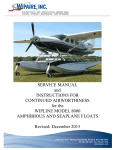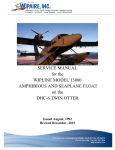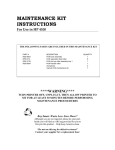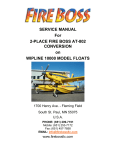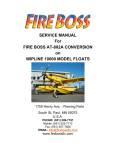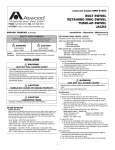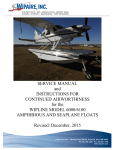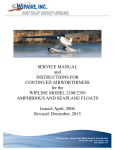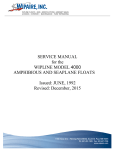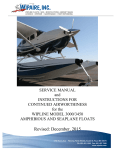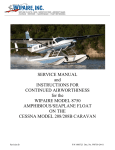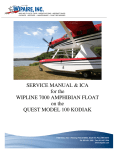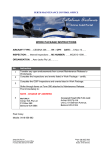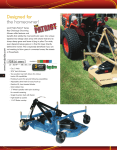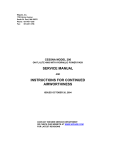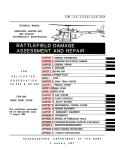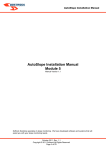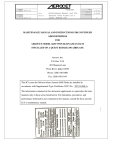Download service manual instructions for continued airworthiness
Transcript
WIPLINE MODEL 8000 FLOAT SERVICE MANUAL AND INSTRUCTIONS FOR CONTINUED AIRWORTHINESS REVISED May 2008 CONTACT WIPAIRE SERVICE DEPARTMENT OR CHECK OUR WEBSITE AT WWW.WIPAIRE.COM FOR LATEST REVISIONS SERVICE MANUAL FOR 8000 FLOATS This page Blank 1002554 2 Rev E SERVICE MANUAL FOR 8000 FLOATS LOG OF REVISIONS REV A PAGES 3 DESCRIPTION Revised Aircraft jacking position DATE 3-16-05 B 12,18 Added greasing zerk to tasks and changed drawing 9-28-05 C 7, 12 Added an inspection time limit and tolerances for the Nose Block Track wear. 4-18-06 D 19-22 Made several additions to the inspection checklist. 1-18-07 E 1002554 3 Rev E SERVICE MANUAL FOR 8000 FLOATS This page blank 1002554 4 Rev E SERVICE MANUAL FOR 8000 FLOATS TABLE OF CONTENTS SECTION PAGE 1. GENERAL . . . . . . . . . . . . . . . . . . . . . . . . . . . . . . . . . . . . . . . . . . . . . . . . . . . . . 1 2. FLOAT HULL MAINTENANCE . . . . . . . . . . . . . . . . . . . . . . . . . . . . . . . . . . . . . 2 3. FLOAT HANDLING, JACKING, AND AIRCRAFT TOWING. . . . . . . . . . . . . . . . 3 4. AMPHIBIAN LANDING GEAR SYSTEM OPERATION & MAINTENANCE. . . . . 3 5. MAIN AND NOSE GEAR OPERATION, REMOVAL AND SERVICE . . . . . . . . . 5 5.1 ADJUSTMENT / TEST . . . . . . . . .. . . . . . . . . . . . . . . . . . . . . . . . . . . . . . . . . . . 7 5.2 MAIN AND NOSE GEAR REMOVAL & DISASSEMBLY . . . . . . . . . . . . . . . . . . 8 5.3 SERVICE SCHEDULE . . . . . . . . . . . . . . . . . . . . . . . . . . . . . . . . . . . . . . . . . . . . 9 5.4 HYDRAULIC PUMP SYSTEM, DISASSEMBLY AND SERVICE. . . . . . . . . . . . 13 6. WATER RUDDER RETRACTION AND STEERING SYSTEM . . . . . . . . . . . . . 22 7. REPAIRING FLOAT HULL SKINS . . . . . . . . . . . . . . . . . . . . . . . . . . . . . . . . . . .22 8. REPAIRING FLOAT HULL EXTRUSIONS. . . . . . . . . . . . . . . . . . . . . . . . . . . . . 23 9. REPAIRING FLOAT HULL SKINS. . . . . . . . . . . . . . . . . . . . . . . . . . . . . . . . . . . 30 1002554 5 Rev E SERVICE MANUAL FOR 8000 FLOATS This page blank 1002554 6 Rev E SERVICE MANUAL FOR 8000 FLOATS 1002554 7 Rev E SERVICE MANUAL FOR 8000 FLOATS This page blank INTRODUCTION 1002554 8 Rev E SERVICE MANUAL FOR 8000 FLOATS This manual describes the general servicing and maintenance for the Model 8000 float, including hull and landing gear. For services and repairs not covered by this manual contact the factory. The service products referred to throughout this manual are described by their trade name and may be purchased from the factory Parts Department. To contact Wipaire for service assistance or parts sales, call or write: Wipaire, Inc. Telephone: Float Dept. (651) 286-7014 Aircraft Parts (651) 306-0459 Fax: (651) 306-0666 Website: www.wipaire.com 1. GENERAL The model 8000 seaplane or amphibious float is an all aluminum constructed float with watertight compartments. The actual displacement in fresh water for each float is 8108 pounds buoyancy for the seaplane and 7922 pounds buoyancy for the amphibian. The amphibian float is geometrically the same as the seaplane except for the addition of landing gear and internal structure for the gear. The water rudder system is cable operated with ball bearing pulleys. Water rudder cables tie into the existing aircraft rudder system. The main landing gear has dual 600 x 6 8-ply tires and the nose landing gear has one 500 x 5 10-ply tire. The gear system is hydraulically actuated and driven by two hydraulic pumps. Brakes are hydraulic and have a caliper on each main wheel for a total of four brakes. Steering on land is accomplished by differential braking. The nose wheels are full castering. Access to the float interior is accomplished by removing covers on the top deck and six covers inside the wheel well. When necessary, water inside the float hulls may be removed through pump out cups located on the outboard edge of each float top skin. 2. FLOAT HULL MAINTENANCE General The float structure is manufactured entirely of 6061-T6 corrosion resistant aluminum sheet and extrusions. Skins on the inside are primed with a 3M SCOTCHWELD primer after being cleaned and acid-etched. Exterior surfaces are cleaned and alodined. Surfaces are then primed with an epoxy-based primer and finished with enamel color paint. Cleaning The outside of the float should be kept clean by washing with soap and water. Special care should be taken to remove engine exhaust trails, waterline marks, and barnacle deposits, as these will lead to corrosion. After saltwater operation, washing with fresh water should be done daily with special attention to hard-to-reach places, 1002554 9 Rev E SERVICE MANUAL FOR 8000 FLOATS such as seams, wheel well, etc. The float interior should be flushed if salt water enters the compartments; it’s easy to tell by the smell inside the float lockers. At night or when the floatplane is in storage, the inspection and/or baggage covers should be opened so the interior has a chance to dry out. THE ABOVE CLEANING TECHNIQUES ARE VITAL FOR KEEPING CORROSION TO A MINIMUM. SALTWATER OPERATIONS ARE STRONGLY LINKED TO CORROSION AND MUST BE ADDRESSED PROACTIVELY. Hard Landing and Damage Investigation After a thorough cleaning of the suspected damaged area, all structural parts should be carefully examined to determine the extent of damage. Frequently the force causing the initial damage is transmitted from one member to the next causing strains and distortions. Abnormal stresses incurred by shock or impact forces on a rib, bulkhead or similar structure may be transmitted to the extremity of the structural member, resulting in secondary damage, such as sheared or stretched rivets, elongated bolt holes or canned skins or bulkheads. Points of attachment should be examined carefully for distortion and security of fastenings in the primary and secondary damaged areas at locations beyond the local damage. Inspect aircraft skins in area of float fitting attach for sign of bending, or any other signs of damage. Corrosion Corrosion is a reaction that destroys metal by an electrochemical action that converts metal to oxide. Corrosion is accelerated when in contact with dissimilar metals such as aluminum and steel, or any material that absorbs moisture like wood, rubber, insulation or dirt. The primary means of detection of corrosion is visual. The most obvious sign is a corrosive deposit of white powder. Other signs are discoloration of the metal surface or bubbles and blisters under the painted surface. Light corrosion may be removed by light hand sanding or chromic acid. Moderate and severe corrosion (blistering, flaking, and pitting) may be removed by heavy sanding or grinding, and applying chromic acid. No more than 1/3rd the thickness of skin material should be removed before complete replacement or reinforcement of an area is necessary. After removing the corroded area, restore area to original finish (prime and enamel). BOESHIELD T9 or ACF-50 may also be applied to stop corrosion. Refer to manufacturer’s instructions for application instructions. 1002554 10 Rev E SERVICE MANUAL FOR 8000 FLOATS Maintaining the float inside and outside finishes by washing after saltwater operations will help protect the float from corrosion. Periodically all hardware should be covered with a waterproof grease or Paralketone. Under saltwater conditions, bolts should be removed at least once a year and grease reapplied to the shafts, heads and nuts. THE ABOVE TECHNIQUES ARE VITAL FOR KEEPING CORROSION TO A MINIMUM. SALTWATER OPERATIONS ARE STRONGLY LINKED TO CORROSION AND MUST BE ADDRESSED PROACTIVELY. 3. FLOAT HANDLING, JACKING, AND AIRCRAFT TOWING To jack the floats for servicing tires, brakes, or doing retraction tests, it is recommended that a floor type jack (three ton minimum.) be used. These jacks are commonly used for truck repair. The jack should be positioned on the keel centerline on the first bulkhead forward of the step. The jack should contact the keel squarely and if room permits, slip a board between the jack and keel. Raise the float slowly, making sure the aircraft stays balanced. After raising, block up the keel in several places and lower the jack. Raise only one float at a time with the opposite float landing wheels chocked. Position a sawhorse under main and after body keel to keep aircraft from tipping fore and aft. When towing the amphibian aircraft, tow lugs are provided on the lower forward side of the nose spring. A rigid “V” frame can be fabricated to attach to these lugs and aircraft towed with a tractor. Wipaire Parts has this tow bar available. A lifting apparatus that will pick the aircraft up by the lifting rings at wing attach points from a ceiling hoist, to be fabricated. Contact factory for details if necessary. 4. AMPHIBIAN LANDING GEAR SYSTEM OPERATION & MAINTENANCE The landing gear incorporated within the amphibious floats on this airplane is retractable, quadricycle type with two swiveling nose (or bow) wheels and four (4) (two (2) sets of dual) main wheels. Air-oil shock struts on the two main landing gear assemblies provide shock absorption. The main landing gear has dual 6:00 x 6 8-ply type III tires and the nose landing gear has one 5:00 x 5 10-ply tire. The gear system is hydraulically actuated and 1002554 11 Rev E SERVICE MANUAL FOR 8000 FLOATS driven by two hydraulic pumps. Brakes are hydraulic and have a caliper on each main wheel. Steering on land is accomplished by differential braking. The nose wheels are full castering. Landing gear extension and retraction is accomplished by two (2) electricallydriven hydraulic pumps and four (4) hydraulic actuators (one (1) for each gear). The hydraulic pumps are located in fuselage aft of cockpit and the hydraulic actuators are located adjacent to each gear. Hydraulic system fluid level should be checked periodically by viewing the sight glass for fluid level in the upper one-third of the range. If fluid is low, fill with MIL-H-5606 or equivalent. Filters are installed on pickup tube inside of hydraulic reservoirs. Clean every 100 hours. Landing gear operation is initiated by movement of the landing gear handle. When the handle is repositioned, hydraulic pressure in the system will drop and pressure switches will automatically turn on the hydraulic pump motors to maintain operating pressure in the system. When the gear cycle is completed, the pump will automatically shut off. If the pressure in the system drops to a preset value, the pressure switches turn the pump motors back on and build up the pressure to the limit again. Eight (8) position-indicator lights four (4) gear UP and four (4) gear DOWN are provided to show landing gear position. Two (2) additional indicator lights show when the landing gear pump motors are operating. LANDING GEAR HANDLE The landing gear handle controls a hydraulic selector valve within the selector head in the instrument panel and has two (2) positions (UP and DOWN LAND) which give a mechanical indication of the gear position selected. From either position, the handle must be pulled out to clear a detent before it can be repositioned. INDICATOR LIGHTS Ten (10) indicator lights are mounted on the landing gear control unit adjacent to the landing gear handle. Four (4) blue indicator lights, labeled NOSE and MAIN (lefthand lights for the left float and right-hand lights for the right float), show by their illumination that the landing gear is up and locked. The four (4) amber indicator lights, labeled NOSE and MAIN (left-hand lights for the let float and right-hand lights for the right float), are illuminated when the landing gear is down and locked. Neither set of lights is illuminated when the landing gear is in transit. Two (2) red indicator lights, labeled PUMP ON 1 and 2 illuminate when current is supplied to the landing gear motors. If the motors continue running during flight or on and off repeatedly, the motors should be shut off by pulling AMPHIBIAN PUMP 1 AND AMPHIBIAN PUMP 2 circuit breakers, since continual running of the motors can result in premature motor failure. Prior to landing, the circuit breakers should be pushed in to reactivate the circuits. Troubleshoot hydraulic problem per section 5.4. LANDING GEAR OPERATION To retract or extend the landing gear, pull out on the landing gear handle and move it to the desired position. When the handle is positioned, pressure on the hydraulic system reduces to where the hydraulic motors automatically turn on. The motors power the hydraulic pumps and actuate the gear actuator for each gear. During operation of the landing gear motors the PUMP ON 1 and 2 indicator lights are 1002554 12 Rev E illuminated. When the gear cycle is completed, pressure builds up in the hydraulic system and automatically shuts off the hydraulic motors. Each gear operates independently of the other, and therefore, the position lights illuminate at various times. EMERGENCY PUMP HANDLE An emergency hand pump is located on the floor between the front seats in the event the normal hydraulic system fails. This hand pump may be used to retract or extend the land gear. To actuate the hand pump, pull out the handle. Prior to utilizing the emergency hand pump, pull the AMPHIB PUMP 1 and 2 circuit breakers to deactivate the electric hydraulic pumps. Select UP and DOWN using the normal landing gear selector handle. Place the emergency hand pump handle in the pump and pump up and down. When a gear reaches the selected position, its indicator light will illuminate. After all four (4) gears are in the selected position there is a noted increase in resistance of hand pump operation. 1002554 13 Rev E SERVICE MANUAL FOR 8000 FLOATS 5. MAIN AND NOSE GEAR OPERATION, REMOVAL AND SERVICE DESCRIPTION AND OPERATION Retraction and extension of the main and nose landing gear is effected by a hydraulic actuation system shown schematically in figure 5.3. The gear system is hydraulically actuated and driven by two hydraulic pumps located in the Aft fuselage. A pressure of between 500 and 1000 psi is maintained in the supply line. When the pressure falls below 500 psi, the pressure switch activates the pump solenoid, providing power to the pump. When the pressure reaches 1000 psi, the pressure switch deactivates the solenoid and the pump motor stops. Figure 5.2 shows the electrical schematic of the system. A check valve on the output side of the pump retains pressure in the system while the pump is off. The pump has an internal relief valve, which directs oil back to the pump reservoir when the line pressure exceeds 1200 psi. The system also has an internal relief valve to protect against thermal expansion when line pressure exceeds 1900 psi. A cockpit mounted control valve accomplishes the selection of gear up or gear down. Each float gear has individual indicator lights on the control valve allowing the pilot to confirm that each gear has fully retracted or extended. An emergency hand pump is provided, in case of total electric pump failure, or loss of fluid. The reservoir has additional hydraulic fluid, available only to the hand pump. The main gear is mechanically locked in both up and down positions. Locking and unlocking is done utilizing a small amount of lost motion of the actuator rod. Retraction takes place when pressure is exerted on the actuator piston driving the collar along the slide tube. The lock is tripped when the follower slides up the contoured track in the actuator as shown in figure 5.3. A reverse process affects extension. Gear position light proximity switches are closed when the appropriate hook (containing the magnetic material) nests over the locking bar. Shock absorption for the main landing gear is provided by a hydraulically dampened air spring. Figure 5.4 shows the main components. The oil and air share a common chamber. When the oleo is collapsed, the oil is forced through the main orifice, compressing the air in the upper cylinder. Extension reverses this process. The extended oleo is initially set at the factory to 210 psi no load. In-field adjustment of air pressure and oil volume is described in this section. The nose gear has an over-center down lock. Retraction occurs when pressure is applied to the forward face of the actuator piston and the carriage is drawn along the tracks in the nose box as shown in figure 5.6. Gear position light proximity switches are closed when the piston containing the magnetic material has reached either end of its travel. The nose gear consists of composite fiberglass beams that are attached at the bottom to castering blocks. Inside the block is a castering pin that is set into the machined fork assembly. The castering pin allows the nose wheel to pivot in a complete circle. The geometry is such that no shimmy dampers are necessary. A 1002554 14 Rev E SERVICE MANUAL FOR 8000 FLOATS spring loaded cam rides in a groove machined in the castering pin. This groove as a flat surface on the back face with the result that the cam provides retention of the pin the block and self-centering of the wheel. SERVICE – NOSE GEAR The nose gear pivot assembly should be cleaned and inspected every 25 hours or more frequently whenever in water for extended period of time, especially saltwater. Nose gear tracks that are the older style gold track and white block are to be lightly greased. Apply grease to a cloth on a stick or rod and run along tracks inside of the nose box, both sides. Newer track and block that are black should be cleaned and left dry or alternately cleaned and wiped with a rag with dry silicone spray on it. The nose wheels contain grease nipples for the wheel bearings. They should be greased every 25 hours. Nose tires are standard 5:00 x 5, 10-ply, inflated to 60 +/- 5 psi. SERVICE – MAIN WHEELS AND BRAKES Grease nipples are provided on all wheels and bearings and should be greased every 25 hours or after an extended period of time in the water. Water/heat resistant grease is recommended and it is important as with any aircraft operations not to mix types of products. The dual piston brakes need no special care other than to maintain the brake disc free of rust, which causes premature brake lining wear. Bleeding is carried out in the usual manner from the bottom up. Main wheel tires are standard 6:00 x 6, 8-ply type III aircraft tires, inflated to 45 +/- 5 psi. (Refer to figure 5-5) SERVICE – MAIN GEAR OLEO Oil Level - The correct level is best set by draining and refilling with the correct quantity of fluid (1140 ml). This should be done with the oleo removed from the float, which process is outlined in Section 5.2. CAUTION: Release air pressure and remove air valve before attempting to service oleo. After filling, refit valve and cap, then pressurize to 210 psi. (Note: Use only MIL-H-5606 hydraulic fluid.) Air Pressure – The correct air pressure is 210 psi (+/-10 psi) on a fully extended oleo (no load) or it can be inflated to approximately 5-6 inches on an unloaded aircraft while sitting static on level ground. Seals – Seals should be replaced whenever the oleo is disassembled or leaking. CAUTION: Release air pressure and remove air valve before attempting to disassemble oleo. The seals are standard “O” rings whose part numbers are depicted in figure 5.4 5.1 ADJUSTMENT/TEST NOSE GEAR Adjustment of actuator stroke is provided at the ends of the piston rods. 1002554 15 Rev E SERVICE MANUAL FOR 8000 FLOATS The length of the nose gear rod is adjusted such that the over-center knuckle (brass) rollers just bottom out on the down side and the piston just bottoms out on the mounting flange. The up stops nests in the up-stop pin. See figure 5.6 for location and assembly. Nose gear proximity switches are located on clips that are mounted on the outer cylinder body, one on each end. The most forward switch is for the gear down lights and most aft is for the gear up position lights. Set the proximity switch mounting clip along outer cylinder body to a position such that the light goes out when the overcenter track is about ¼ inch from bottomed position while traveling in the up direction. Lights should come on about 1/8 inch from the bottomed position while traveling in the down direction. The cylinder piston has a magnet that will activate the proximity switches. Nose Box Track Wear Due the wear over time the roller/slide block places on the track as the gear are retracted, the block needs to be measured for the amount of wear. The tolerance for wear is .050 inches. If the wear is, or is less than the limit, it can still be used. If the wear in the track is greater than .050 inches, the block must be replaced. This check is to be done every 200 hours and is part of the maintenance checklist. On the 8000 Series Floats Gear Track P/N 8A07337 (-003 LT -004 RT) SERVICE – MAIN GEAR RETRACTION SYSTEM As explained in Section 5.0, retraction involves the main gear carriage moving back and forth along the slide tube. The locking mechanism also moves a small amount in service, enabling the locking hooks to hook and release as the gear locks in the up or down position. Consequently, the slide tube and the main gear ram must stay lubricated despite varying operating circumstances in order to work as intended. Greasing might not be necessary, depending on operations, but these areas should be inspected visually at least every 25 hours for cleanliness and lubrication. The slide tube, gear locking ram and main carriage can be accessed at various points of operation via the top deck panels or via the main wheel well with the tire off. Recommended grease is HCF Grease, P/N 605 available from our parts department. Care should be taken as with all aviation maintenance not to mix different types of greases, especially in critical areas like this. Grease needs to be applied directly along the length of the slide tube shaft and locking ram in addition to using a grease gun for the zerk on the main carriage. Grease should be pumped several times past the point at which it comes out the front of the carriage so it can migrate all the way thru the system to the locking hooks. Also, LPS 2 should be applied to the locking hooks while their top cover is removed. The main gear actuator cylinder is not adjustable. These are pre-set at the factory to ensure that the main gear is locked at the end of each stroke and that correct indication is given on the cockpit console. The up and down lock may be adjusted so the lock is fully engaged by adjusting the set screws shown in figure 5.3. Loosen the jamb nut adjust and tighten jamb nut. The main gear proximity switches are located on each end of the gear stroke. The forward switch is located on the forward side of the gear tunnel. It is accessible 1002554 16 Rev E SERVICE MANUAL FOR 8000 FLOATS through the top deck access cover. The aft proximity switch is located on the float bulkhead just aft of the wheel well, accessible though the float top deck cover. The main gear proximity switches are adjusted loosening the mounting screws and positioning them as such that the light goes out when the lock hook is raised about 1/8 inch off its nested position and comes on again upon nesting. BLEEDING HYDRAULIC SYSTEM AFTER SERVICE The system automatically bleeds, provided sufficient oil is maintained in the reservoir. To check the fluid level, fill the reservoir with hydraulic oil and cycle the gear. The fluid level should be maintained in the upper one third (1/3) of the sight glass. If the reservoir empties (i.e. fluid disappears in sight glass) stop the cycle by pulling the circuit breaker on the control panel. Fill the reservoir again and complete the cycle. Continue this procedure until the fluid level in the reservoir stabilizes (it will vary in level between up and down positions). If the fluid level continues to decline during gear cycles, check for external leaks. 1002554 17 Rev E SERVICE MANUAL FOR 8000 FLOATS 5.2 MAIN AND NOSE GEAR REMOVAL AND DISASSEMBLY REMOVAL OF MAIN GEAR OLEO Jack the aircraft by method described in section 3. With main wheels off the ground (both sides), run the gear up so that the main carriage is approximately 2 inches forward of down lock position. This must be accomplished to remove the top oleo bolt. In order to remove the lower bolt, it is necessary to remove the wheel on the head side of the bolt. Shock Strut Servicing NOTE: Be sure pressure from gas and fluid have been release before starting to disassemble the strut. 1) Disassemble the strut, removing both end caps, taking apart the gland section and metering pin so the parts can be easily inspected for wear and replacement parts can be added. 2) Inspect all parts carefully after cleaning for wear and scoring, especially the piston, gland section, and the inside of the outer cylinder. Also make sure to check the bushings in the end-caps for wear and security. 3) The metering tube does not need to be taken apart form the end-cap of the inside cylinder unless extensive cleaning is desired. If it is disassembled: a) To return the metering tube height and condition to factory preset, first apply blue lock-Tite to the threads of the inner end-cap threads that hold the metering pin for added security until next removal. 1002554 18 Rev E SERVICE MANUAL FOR 8000 FLOATS b) The metering pin is threaded until the measurement from the floor of the inside of the end-cap to the end of the inserted metering tube is 12.037 inches if the new Tseals are being used and 11.937 inches if the old style O-rings are used. c) Tighten the associated jam nut at that end and stake it for added security. d) Set this metering tube assembly aside and move on to next steps. 4) On the other end, install the metering pin with Lock-Tite onto the end-cap and tighten to approx. 30 ft./lbs. 5) Install outer T-seal to end-cap with Vaseline. Also lube the inside of the outer cylinder where the end-cap seats for ease of assembly. NOTE: Use Vaseline or equivalent as it dissolved in hyd. fluid. 6) Install the end-cap bolts with gasket sealer on the threads for added security to 1002554 19 Rev E 25-30 in./lbs. making sure not to over-tighten, there-by damaging the T-seal. Set this part of the unit aside and move on to next steps. 7) To assemble the gland assembly, insert the inside T-seal and wiper, again using Vaseline on the T-seal. a. The gland much be installed from the end-cap side (this is the side without the holes). b. Lube the outside of the inner cylinder with hyd. fluid for ease of assembly. c. Install the T-seal into the end-cap, again using Vaseline for lube. d. Install the inner cylinder into the end-cap (the end of the tube without holes). 1002554 20 Rev E SERVICE MANUAL FOR 8000 FLOATS 8) For piston install, place the piston onto the metering tube using hyd. fluid to prevent damage to the threads. a. Using a spanner wrench, tighten the piston to the inner cylinder. b. Install the jam nut onto the piston end of the metering tube and stake for security. c. Install the 2 T-seals onto the exterior of the piston and gland, and lube with Vaseline. 9) Gently clamp the outer tube end in a vise and add 1900 ml of hyd. fluid (5606 or equivalent). 10) Lube the inside of the outer cylinder where the gland and the piston will rest. 11) Install the inner cylinder into the outer assembly, making sure that the gland is seated against the piston. 1002554 21 Rev E SERVICE MANUAL FOR 8000 FLOATS 12) Re-install the units center bolts using gasket sealer. 13) Install the O-ring onto the fill/drain plug before installing the plug onto the end-cap and tighten. 1002554 23 Rev E SERVICE MANUAL FOR 8000 FLOATS 14) Install the O-ring onto the Schraider valve and install onto the outside of the endcap. NOTE: Align Schraider valve 180 degrees from the Placard. NOTE: Double check the plugs and bolts for proper Installation and security before adding gas charge. 15) Fill the strut with nitrogen to 250 psi +/_ 10 psi and close the valve and cap. 1002554 23 Rev E REMOVAL OF MAIN GEAR RETRACTION CYLINDER Relieve pressure in system, place gear selector handle in neutral position (lever between up and down), and remove hydraulic lines. Remove end cap from end of cylinder. Drain fluid. Remove forward end of cylinder from bulkhead flange. Remove cylinder support ring from bulkhead. NOTE: Piston to be in the up position for cylinder removal. Remove cylinder from piston and up through top float inspection cover. To remove piston, remove top inspection cover on top forward end of gear tunnel, accessible from top float inspection cover forward of step. Pull back piston to expose top of carriage in center of access cover. Remove .25 dia. retention bolt. Remove piston by pulling aft. See figure 5.3 for part breakdown. REMOVAL OF MAIN GEAR DRAG LINK Remove drag link from trunnions on step bulkhead. Axle is heat shrunk to drag link and is not removable. REMOVAL OF NOSE GEAR FROM NOSE BOX Gear must be in down position. Relieve pressure in system, place gear selector handle in neutral position (lever between up and down), and remove rear hydraulic line. Remove (4) bolts on forward end of cylinder. Drain fluid. Pull aft to expose internal piston rod. Loosen jamb nut on forward side of cylinder ram at rod end. Turn piston from aft side of nose box out of rod end. Lift up on gear assembly to unlock. Slide out of nose box. Note: On installation adjust piston so it bottoms out on aft flange when nose gear is in locked position. Also note orientation of trolley blocks. The side with the most edge distance from hole is to go toward each other on inside of trolley. (See figure 5.6 for details). REMOVAL OF NOSE GEAR BOX Remove bolts securing forward box from nose bulkhead. Remove bolts securing aft box from bulkhead (2). Slide box out from front of float. Note: Sealant will have to be cut for removal and replaced when installing. REMOVAL OF LOWER NOSE GEAR FROM PIVOT BLOCK With weight off of the nose wheel, remove 2 bolts on plate on aft side of pivot block. Remove spring and detent piston. Nose fork assembly will drop down from pivot block . 1002554 24 Rev E SERVICE MANUAL FOR 8000 FLOATS 5.3 SERVICE SCHEDULE As coded in the Inspection Time Limits chart in this section, there are items to be checked each 25, 50, 100, and 200 hours. Also, there are notes on special items which may require servicing at more frequent intervals. * When conducting an inspection at 25 hours, all items marked for 25 hours would be accomplished. * When conducting an inspection at 50 hours, the 25 and 50-hour items would be accomplished. * When conducting an inspection at 100 hours, the 25, 50, and 100-hour items would be accomplished. * When conducting an inspection at 200 hours, the 25, 50, 100 and 200-hour items would be accomplished. * A complete inspection (Annual Inspection) would include all 25, 50, 100, 200 hour items. Below is a list of recommended lubricants and “protection” products when servicing float hull, amphibious components. This lists products used by Wipaire during assembly of the floats. There may be equivalent products just as satisfactory for protection. However, it is recommended if trying different products, to inspect them frequently so as to determine their effectiveness. Protection of nuts, bolts, hydraulic lines, metal surfaces, or electrical connections. Dinitrol AV30 Dinol Group CRC – SP400 Soft Seal CRC Industries General Lubricants LPS 1, LPS 2 and LPS 3 LPS Industries Wheel Bearings, Main Gear Retract Mechanism, Nose Gear Pivot and Rod Ends HCF Grease, P/N 605 HCF Industries Rust Protection Boeshield T9 Rust Protection Boeing Company ACF-50 Rust Protection 1002554 25 Rev E SERVICE MANUAL FOR 8000 FLOATS Float Sealant 890 B2 or B4 Pro Seal Company RTV Silicones General Electric SIKAFLEX 201 or 252 Sika Manufacturing Teflon Spray 6P-730A Comet Industries Hydraulic Fluid Mil-H-5606 Bolts in Critical Areas - For common, correct torque when installed, or when visual inspection indicates a need for a torque check. Nut -Bolt Size 8-36 10-32 1/4-28 5/16-24 3/8-24 7/16-20 1/2-20 9/16-18 5/8-18 3/4-16 7/8-14 1-14 1 1/8-12 1 1/4-12 Torque Limits In-lbs Min. Max. 12 15 20 25 50 70 100 140 160 190 450 500 480 690 800 1,000 1,100 1,300 2,300 2,500 2,500 3,000 3,700 4,500 5,000 7,000 9,000 11,000 5.4 HYDRAULIC PUMP SYSTEM, DISASSEMBLY AND SERVICE The hydraulic pump is factory preset to the following pressures: Pressures switch operates below 500 psi and shuts off at 1000 psi. The pump also has an internal relief valve that opens at 1200 psi and a thermal relief valve that opens at 1900 psi. These pressures are set with factory test equipment and are recommended to be sent back for overhaul or repair. The unit may be disassembled for cleaning. 1. Relieve the pressure in the hydraulic system by placing the gear selector handle in the neutral position. 2. On the forward lower side of the reservoir, remove drain plug to drain most of the hydraulic fluid. 1002554 27 Rev E SERVICE MANUAL FOR 8000 FLOATS 3. Remove the (4) screws on each tank (2) on upper side of the reservoir. 4. 5. 6. 7. 8. 9. Dump out remaining oil, and clean reservoir. Unscrew stand pipe with the filter attached. Clean filter. If filter is removed from stand pipe, a new filter should be used. Reinstall tank and install seals to top of reservoir before installing on pump. Install drain plug and fill with clean MIL-H-5606 hydraulic fluid through the breather pipe. 10. Fluid level should be in the upper 2/3 of the sight gauge 1002554 27 Rev E INSPECTION TIME LIMITS & CHECKLIST * A complete inspection (Annual Inspection) would include all 25, 50, 100, 200 hour items. INSTRUCTIONS/PROCEEDURES HOURLY LIMITS MECHANIC INSP. General General Details 25 Wash aircraft and floats with fresh water and inspect surfaces, hardware and strut connections for corrosion. If the airplane is exposed to salt- or polluted water, the chances for corrosion increase dramatically. Daily basic cleaning is essential. X or more often 50 X Check installed placards against the AFM or POH, and installation drawings. Hulls & Struts Float Installation Boarding steps: disassemble as needed and grease the step slide tubes. Disassemble and grease the flying wire clevis bolts/pins. Float Interiors Float structure (interior): pull up baggage floors and inspect bulkheads. Baggage compartment covers and seals inspect for condition, security, operation, excessive wear and corrosion under nutplates. Pumper Tube Installation - inspect for condition, security, routing of hoses. 1002554 100 200 Annual Right Left X Float exterior - inspect for damage, wrinkled metal, corrosion, paint loss, etc. If the floats are installed, remove the center section fairings for access. Struts and attach fittings: clean upper attach fittings and dog bone saddle area. If off aircraft, regrease bolts and return. Spreader Bars: inspect for loose screws and cracks & seal between fairing and side skin. Insp. fairings for cracking and loose screws. X X X X X X On the aircraft and floats: re-coat exposed hardware with suitable coating for corrosion protection. Closely inspect for wrinkled metal & cracked flanges; watch closely bulk heads 9-21. After hardware inspection, coat with anti-corrosion grease to protect. X X X X X X X 28 X Rev E SERVICE MANUAL FOR 8000 FLOATS INSPECTION TIME LIMITS & CHECKLIST INSTRUCTIONS/PROCEEDURES Water Rudder System & Tail Electrical System General Details Water rudder boots - inspect for cuts, tears, and condition Water rudder blades and posts inspect for damage, security of attachment, corrosion, paint, rigging. Check post bolts and bushings and lube with LPS 2. Check top and bottom rollers for rotation and lube with LPS 2 or similar product. Water rudder steering and retract systems - inspect the following: cables for broken wire; fittings for cable slippage, cracks and distortion; cable pulleys for freedom of rotation and cable guard pins for presence; rigging On the aircraft: remove clean, inspect and grease the aux. finlets on the horizontal stabilizer. Pump and indicator light wiring - inspect for chafing, broken or loose terminals and general condition. Solenoids - inspect wiring, mounting and general condition. 25 Nose Gear Box/Block Tracks measured at slide route for wear, .050 inches or less wear tolerance. 1002554 100 200 Annual Right Left X X X X Pump Motors - inspect wiring, mounting and general condition. Inspection and servicing nose gear tracks: 50 X Pressure Switches - inspect wiring, mounting and general condition. Landing Gear Systems MECHANIC INSP. HOURLY LIMITS Gold and white track and block clean and use grease. Black track and block – clean and dry or clean and wipe with silicone spray. Check side play – 3/32 to 1/16 inches max tolerance. 28 X X X X X X X X X X X Rev E X INSPECTION TIME LIMITS & CHECKLIST INSTRUCTIONS/PROCEEDURES General Details Nose gear pivot blocks and forks - inspect for condition, lubrication, corrosion, paint. Nose & main wheel bearing - grease Zerks Insp. Main gear slide tube, ram and locking hooks for lubrication. Lube carriage zerk liberally. Hydraulic fluid level: Mil-H-5606 Grease with HCF p/n 605. Spray locking hooks form the top with LPS 2 to penetrate. 25 50 100 200 Annual Right Left X X X X X Wheels and tire - inspect for wear, pressure, condition (45lbs +/_ 5lbs) Brake assemblies - inspect for wear, corrosion, leakage Hydraulic fluid screen - clean and inspect. NOTE: If floats sit for extended periods of time (I.e. If removed during winter months), screen should be cleaned before putting floats back into service. Hydraulic fluid in reservoir should be checked for moisture or other contaminates and changed if necessary. Insp. FWD slide tube mounting bolt for corrosion and wear when the gear are out. Clean and lube the slide tube before returning. Main and Nose gear actuator, assemblies inspect for condition, lubrication, leakage, corrosion, and cleanliness. With gear out: Inspect FWD slide tube mounting bolt for corrosion and wear. Clean & grease FWD slide tube. Nose gear springs - scotchply springs, inspect for cracks, delamination and paint. Main gear drag link garlock bushings inspect for condition, lubrication, and corrosion. 1002554 MECHANIC INSP. HOURLY LIMITS X X X X X X X X X 30 X X X X X X Rev E INSPECTION TIME LIMITS & CHECKLIST INSTRUCTIONS/PROCEEDURES 25 50 Clean the wheel wells to facilitate general condition inspection. Main gear oleos - inspect for evidence of leakage, proper extension, check cylinder for corrosion, pitting, cleanliness and security Hydraulic lines and fittings - inspect for leaks, condition and security. MECHANIC INSP. HOURLY LIMITS 100 200 Annual X X X X X X Hydraulic Manifolds (if equipped) - inspect for condition, security, and leaks. X X Brake system plumbing - inspect for leaks, condition and security. X X Main gear oleos – Check for static compression, leaks and proper pressure. The oleo should be fully serviced or replaced with overhauled as required. Perform retraction test: Nose and main wheel bearings - disassemble and inspect 1002554 Refer to section 5.2 If full servicing is required, use 5606 hydraulic fluid & Nitrogen Refer to section 5.2 X X Inspect main gear up and down lock hooks for proper engagement. X X Inspect nose gear trolley for proper travel. X X Inspect nose gear for excessive play in the down position X X Perform emergency gear extension & retraction X X Re-grease bearings with recommended water resistant grease X 36 Right Left X Rev E SERVICE MANUAL FOR 8000 FLOATS CESSNA 208 FLOAT REMOVAL INSTRUCTIONS/PROCEEDURES MECHANIC THIS IS INTENDED AS A GENERAL GUIDE. EACH INSTALLATION MAY HAVE Right SUBTLE DIFFERENCES. ALWAYS USE THE INSTALLATION DRAWINGS AS THE FINAL REFERENCE. ALL WORK SHOULD BE DONE BY CERTIFIED AIRCRAFT TECHNICIONS. 1. Connect the lifting bar to the hoist and position aircraft underneath INSP. Left 2. Remove wing gap strips 3. Inspect aircraft lifting rings for proper assembly and installation before connecting lifting bar to the aircraft 4. Attach ropes and ballast to tie-down rings as required to keep aircraft level while lifting 5. Lower aircraft so wheels just touch and relieve hydraulic pressure before Pulling pump circuit breakers. Install tie-wrap to shank for safety 6. Remove from aircraft : Nose gear cover plate Lower left cowling Steering bungee from nose gear attach Front flying wire fitting Strut fairings and belly plate Tail hatch cover & tail cone (if needed) Rear cargo struts and step assembly Auxiliary fins (cover holes with cover plates) Nuts from top bolts in forward struts Bolts from front step struts Cotter pins from pulley brackets under cargo door 1002554 32 Rev E SERVICE MANUAL FOR 8000 FLOATS MECHANIC (CONT.) CESSNA 208 FLOAT REMOVAL INSTRUCTIONS/PROCEEDURES THIS IS INTENDED AS A GENERAL GUIDE. EACH INSTALLATION MAY HAVE Right SUBTLE DIFFERENCES. ALWAYS USE THE INSTALLATION DRAWINGS AS THE FINAL REFERENCE. ALL WORK SHOULD BE DONE BY CERTIFIED AIRCRAFT TECHNICIONS. (remove from aircraft) Aft cabin bulkhead and cabin seats as required Floor cover plates for access to steering cables Fairleads from under the cabin floor Elevator down-spring and cable Hydraulic lines at the RT. front strut location and cap Retract cable (Secure in main gear well) Break lines and cap Electrical cannon plug in main wheel well Steering cables in tail. Remove rudder horn or clamp to main rudder Cables 7. Assemble main gear if needed 8. Install nose gear and attach steering bungee 9. Assemble support crew (minimum 6 people) 10. With wheels just touching the ground, remove the 4 main gear saddles and Upper front attach bolts 11. Lift aircraft and remove floats 12. Lower aircraft and install main gear assembly INSP. Left 13. Torque main gear saddle bolts to 75 ft. lbs. 1002554 33 Rev E SERVICE MANUAL FOR 8000 FLOATS (CONT.) CESSNA 208 FLOAT REMOVAL INSTRUCTIONS/PROCEEDURES MECHANIC THIS IS INTENDED AS A GENERAL GUIDE. EACH INSTALLATION MAY HAVE Right Left SUBTLE DIFFERENCES. ALWAYS USE THE INSTALLATION DRAWINGS AS THE FINAL REFERENCE. ALL WORK SHOULD BE DONE BY CERTIFIED AIRCRAFT TECHNICIONS. 14. connect brake lines and bleed for air bubbles 15. Install main gear belly plate and fairings 16. Remove front strut fittings 17. Install pilot and co-pilot step assemblies 18. Install tail cone and tail hatch cover 19. Install lower LT. cowling 20. Install all nose gear fittings 21. Install all floor plates and carpet 22. Install aft bulkhead 23. Install any seats previously removed 24. Remove aircraft from hoist & add air to tires as required 25. Install wing-root fairings 26. Check all placards to conform to landplane category 27. Make logbook entry INSP. NOTES 1002554 34 Rev E SERVICE MANUAL FOR 8000 FLOATS MECHANIC CESSNA 208 FLOAT RE-INSTALL INSTRUCTIONS/PROCEEDURES THIS IS INTENDED AS A GENERAL GUIDE. EACH INSTALLATION MAY HAVE Right SUBTLE DIFFERENCES. ALWAYS USE THE INSTALLATION DRAWINGS AS THE FINAL REFERENCE. ALL WORK SHOULD BE DONE BY CERTIFIED AIRCRAFT TECHNICIONS. 1. Remove the nose and main gear fairings and the belly plate 2. Remove wing gap strips and the tail cover 3. Install the finlets and seal 4. Remove aft panel inspection covers for hydraulic pump access and cables 5. Remove pilot and co-pilot steps 6. Install front strut fittings 7. Disconnect brake lines and cap 8. Cut tie-wrap from pump circuit breakers 9. Remove fuel before lifting aircraft 10. Tie ropes from tie-down rings. Connect lifting bar to hoist and inspect Aircraft lifting rings for proper assembly before connecting to aircraft. Use Ballast from tie-down ropes to ensure level lifting. 11. Raise aircraft until wheels are just touching the ground and assemble Crew (minimum 6 people) for installation 12. Remove saddles holding main gear in place. With support crew stabilizing Aircraft, hoist aircraft clear of main gear and roll away from aircraft 13. Lube saddles on aircraft and saddle bolts and position float under plane 14. Lower aircraft to floats, install front struts first then lower aircraft onto Saddles and install clamps 15. Torque the saddle bolts to 75 ft/lbs INSP. Left 16. Remove the nose gear 1002554 35 Rev E SERVICE MANUAL FOR 8000 FLOATS MECHANIC (CONT.) CESSNA 208 FLOAT RE-INSTALL INSTRUCTIONS/PROCEEDURES THIS IS INTENDED AS A GENERAL GUIDE. EACH INSTALLATION MAY HAVE Right SUBTLE DIFFERENCES. ALWAYS USE THE INSTALLATION DRAWINGS AS THE FINAL REFERENCE. ALL WORK SHOULD BE DONE BY CERTIFIED AIRCRAFT TECHNICIONS. 17. Install the flying wire fitting. Install flying wires, rig with regard to airflow 18. Secure the steering bungee & connect the hydraulic lines 19. Locate jack stands under floats 20. Perform gear check & ensure all lights agree with gear and gear advisory 21. Cycle time up? Cycle time down? Check for leaks. 22. Hand pump the gear down and up and check for leaks again. 23. Install springs for steering cables in the tail of the aircraft 24. Route and rig the steering cables & water rudder retract cables 25. Install step struts 26. Install break lines and bleed for air bubbles 27. Install elevator down-spring 28. Install belly plate and fairings for main gear 29. Install tail inspection cover, cowlings and wing gap strips 30. Inflate tires to 45 lbs +/- 5 lbs 31. Remove aircraft from stands. Check for proper main oleo extension (section 5) 32. Check aircraft placards against the drawings for accuracy 33. Plug nose leg fairing holes and pilot and co-pilot step holes. 34. Make logbook entry & check for proper placarding. 1002554 35 Rev E Left INSP. DESCRIPTION AND OPERATION 1. PROBLEM – Powerpack does not run after gear selection. PROBABLE CAUSE a. Circuit breaker has failed b. Pressure switch not pulling in at low cut in. c. Solenoid switch not pulling in. d. Faulty pump motor. e. Motor not properly grounded. VERIFICATION AND REMEDY a. Reset circuit breaker. b. Short across pressure switch leads and see if motor runs. If motor operates, replace pressure switch. c. Short across solenoid pressure switch leads and see if motor runs. If motor operates, replace solenoid pressure switch. d. If c. above does not produce results and it is verified that voltage was actually applied to motor, it can be assumed motor is bad or not properly grounded. e. Check motor ground. 2. PROBLEM – Powerpack does not shut off after gear reaches position. PROBABLE CAUSE a. Faulty pressure switch. b. Faulty or dirty pressure relief valve allowing insufficient pressure buildup. REMEDY a. Replace pressure switch. b. Clean and check relief valve. 3. PROBLEM – Powerpack shuts off before gear reaches position. PROBABLE CAUSE a. Binding or jammed gear retractor, which causes pressure to build up (and stay up), and pressure switch shuts off powerpack. b. Faulty or dirty pressure relief valve allowing insufficient pressure buildup. REMEDY a. Repair retractor. 4. PROBLEM – Powerpack cycles on and off after gear is in position. PROBABLE CAUSE a. Internal hydraulic leak. b. External hydraulic leak. 1002554 37 Rev E REMEDY a. Verify leak is not external by checking fluid level in reservoir and looking at couplings for oil leaks. If no external leaks are found, disconnect and cap off the hydraulic actuators one at a time and find the leaky one by process of elimination. If isolating entire system still indicates internal leak, powerpack check valve (located in pressure port of pump) is bad and needs replacement or reseating. b. Visually inspect lines, cylinders, and hoses and replace as necessary. 5. PROBLEM – Powerpack cycles on and off during gear cycle. PROBABLE CAUSE a. Binding in retraction unit. b. Pressure switch cut off limit too low. REMEDY a. Investigate for free operation. Check gear that retracts last. b. Replace pressure switch. 6. PROBLEM – Slow gear operation cycle (considerably longer than 30 seconds.) PROBABLE CAUSE a. Plugged oil screen. b. Poor electrical connection to motor. c. Poor motor. d. Worn pump gears. REMEDY a. Clean intake screen located inside reservoir tank. b. Connect motor direct to 24 volt source and note its operation; if good, wire connection is bad; if operation poor, motor needs overhaul. c. Covered in b. above. d. Replace pump. 7. PROBLEM – Circuit breaker pops during cycle. PROBABLE CAUSE a. Wire connections bad or corroded. b. Bad motor brushes. c. Bad circuit breaker. REMEDY a. Clean and protect terminal with grease. b. Overhaul motor. c. Replace circuit breaker. 1002554 58 Rev E SERVICE MANUAL FOR 8000 FLOATS Figure 5-1 1002554 39 Rev E SERVICE MANUAL FOR 8000 FLOATS Figure 5-2. 1002554 40 Rev E SERVICE MANUAL FOR 8000 FLOATS FIGURE 5.3 ASSEMBLY MAIN GEAR RETRACTION SYSTEM 1002554 41 Rev E SERVICE MANUAL FOR 8000 FLOATS VALVE BEARING PISTON RETAINER 4115B001TP037 T-SEAL (OUTSIDE RETAINER - PISTON) WIPER 4115B001TR035 T-SEAL (INSIDE RETAINER) INNER CYLINDER METERING TUBE LOWER CAP 4115B01TP037 T-SEAL AN6227-14 "O" RING OUTER CYLINDER CAUTION: REMOVE PRESSURE BEFORE DIASSEMBLY METERING PIN Rev E 42 1002554 4115B001TR035 T-SEAL UPPER CAP AN62278-9 FILL PLUG Figure 5.4 Assembly – Main Gear Shock Strut SERVICE MANUAL FOR 8000 FLOATS FIGURE 5-5 ASSEMBLY MAIN GEAR AND BRAKE (Refer to Parts Manual for complete parts list) 1002554 43 Rev E SERVICE MANUAL FOR 8000 FLOATS FIGURE 5-6 ASSEMBLY NOSE GEAR SYSTEM 1002554 44 Rev E SERVICE MANUAL FOR 8000 FLOATS Weighing procedures for Cessna 208A Caravan Level aircraft per manufacturer’s instructions or use the cabin door lower sill. Place scales under the right and left main and nose gears. Place blocking under the right and left main gears to level aircraft. Draw lines on the floor from the centerline main wheels and centerline nose wheel left to right. Drop a plumb bob from the face of the firewall. This is station 100.00. Measure 100.00 inches forward of this point, this is the datum, 0.0. Draw another line between the nose wheel centers and a 4th line between the main wheel centers. Measure the distance from 0.0 to the nose wheel line. This is X. Measure the distance from 0.0 to the main wheel line. This is Y. If the floats are seaplane floats, the scales go under the step point in the rear and a point towards the front of the float. These distances are measured and become the same X and Y as for the amphibian. Scale Reading Distance from 0.0 Weight x Arm Weight x Arm = Moment Left Front + + X + Right Front + + X + + + Y + + + Y + Left Rear Right Rear Totals Notes: 1. Zero out or deduct tare weights at the Y arm. 1002554 45 Rev E SERVICE MANUAL FOR 8000 FLOATS 6. WATER RUDDER RETRACTION AND STEERING SYSTEM Description The water rudder-retract system is manually operated by a lever through a system of cables and pulleys. Steering is directed from the aircraft rudder steering system. Adjustment Rigging of the water rudder steering cables is accomplished by centering the airplane rudder and adjusting the turnbuckles such that both rudders trail with the float center line. Cables should be tensioned to 10 pounds, +/- 5 psi. Retraction cables should be rigged such that the top of the rudder blade is against the rudder stop on the rudder posts in the up position and that the cables are just slack in the down position. Service Schedule Cables - inspect for fraying annually. Pulleys - inspect and lubricate annually. 7. REPAIRING FLOAT HULL SKINS The float hull is manufactured from the following aluminum alloys: Top skins and side skins are .032" thick, 6061-T6, the bottom skin is .040" thick, 6061-T6; the nose bulkhead is .100" thick, 6061-T6; all remaining forward bulkheads are .032" thick, 6061-T6; The aft wheel-well bulkhead is .050" thick, 6061-T6; the afterbody skin is .032" thick, 6061-T6; all afterbody bulkheads are .040" thick, 6061-T6. Damage to the skins may be repaired per Figures 7-1, 7-2, 7-3, or any acceptable repair method listed in FAA Advisory Circular 43.13.1A. Any float hull skin or part thereof can be purchased from Wipaire to aid in repair. To simplify repairs, the skins can be ordered precut to shape. All outside hull skins are bonded to the extrusions with a special heat pressure 3M adhesive. This bond adheres skins to the inside of all extrusions. Skins may be reattached to extrusions by methods shown in figures in 7-4, 7-5, and 7-6. If the skin bond must be broken from an extrusion for a long distance the caulking material must first be removed from the exterior crack. Then heat the extrusion with a propane torch until the bond starts to loosen. Caution must be taken not to heat and loosen bonds not needing replacement. 1002554 46 Rev E SERVICE MANUAL FOR 8000 FLOATS 8. REPAIRING FLOAT HULL EXTRUSIONS All extrusions in the float hull are formed 6061-T6 aluminum alloy. Extrusions have channels on both sides which the hull skins are bonded to. All extrusions may be repaired by splicing as shown in figure 8-1 and 8-2 or capped as shown in figure 8-3. Splicing normally is done when both sides of an extrusion are damaged. Capping is done when only the outside of an extrusion is damaged, such as the main keel during gear up landings on pavement. Capping also is done when the original skin is still bonded to the inside of the extrusion. Sections of extrusion for splicing or capping may be purchased from Wipaire in any length needed. Stub skins can also be bonded on extrusion sections if desired, to simplify the repair. There are many ways to repair Wipline floats and each method depends on the degree and location of the damage. The following figures are examples of some repairs. For additional help contact the Wipline float factory at 651-451-1205. 1002554 47 Rev E SERVICE MANUAL FOR 8000 FLOATS FIGURE 7-1. TYPICAL SKIN REPAIR 1. 2. 3. 4. 5. 1002554 Trim hole as shown by dotted line. Patch material to be at least same thickness as original skin. Prime all bare surfaces. Seal between patch and skin. Rivet in place. 48 Rev E SERVICE MANUAL FOR 8000 FLOATS FIGURE 7-2 TYPICAL SKIN REPAIR 1002554 49 Rev E SERVICE MANUAL FOR 8000 FLOATS FIGURE 7-3 TYPICAL SKIN REPAIR 1002554 50 Rev E SERVICE MANUAL FOR 8000 FLOATS FIGURE 7-4. TYPICAL REPAIR BOTTOM SKIN TO KEEL INSTRUCTIONS (Preferred method) 1. 2. 3. 4. 5. 1002554 Remove original damaged skin cut flush with extrusion. Remove caulking from groove of extrusion. Apply sealant in groove. (Be sure to use plenty of sealant!) Insert repair skin into extrusion. Drill and countersink holes and rivet into place. 51 Rev E SERVICE MANUAL FOR 8000 FLOATS FIGURE 7-5. TYPICAL REPAIR BOTTOM SKIN TO KEEL INSTRUCTIONS. 1. 2. 3. 4. 5. 6. 1002554 Remove original damaged skin from extrusion. Remove caulking from groove of extrusion. Apply sealant in groove. (Be sure to use plenty of SEALANT!) Insert repair skin into extrusion. Install spacer between repair skin and extrusion. Drill and countersink holes and rivet into place. 52 Rev E SERVICE MANUAL FOR 8000 FLOATS FIGURE 7-6 TYPICAL REPAIR BOTTOM SKIN TO KEEL (ALT) INSTRUCTIONS (ALTERNATE METHOD) 1. 3. 3. 4. 5. Remove original damaged skin leaving approximately 1 ½” of skin protruding from extrusion. Remove caulking from groove in extrusion. Install sealant in groove. (Be sure to use plenty of SEALANT!) Insert repair skin in groove approximately ¼”. Layout hole pattern, drill, de-chip, seal and rivet. 1002554 53 Rev E SERVICE MANUAL FOR 8000 FLOATS 9. REPAIRING FLOAT HULL SKINS All extrusions in the float hull are formed 6061-T6 aluminum alloy. Extrusions have channels on both sides which the hull skins are bonded to. All extrusions may be repaired by splicing as shown in figure 8-1 and 8-2 or capped as shown in figure 8-3. Splicing normally is done when both sides of an extrusion are damaged. Capping is done when only the outside of an extrusion is damaged, such as the main keel during gear up landings on pavement. Capping also is done when the original skin is still bonded to the inside of the extrusion. Sections of extrusion for splicing or capping may be purchased from Wipaire in any length needed. Stub skins can also be bonded on extrusion sections if desired, to simplify the repair. There are many ways to repair Wipline floats and each method depends on the degree and location of the damage. The following figures are examples of some repairs. For additional help contact the Wipline float factory at 651-451-1205. 1002554 54 Rev E SERVICE MANUAL FOR 8000 FLOATS FIGURE 8-1 TYPICAL REPAIR SPLICE OF KEEL 1002554 55 Rev E SERVICE MANUAL FOR 8000 FLOATS FIGURE 8-2 TYPICAL REPAIR SPLICE OF CHINE 1002554 56 Rev E SERVICE MANUAL FOR 8000 FLOATS FIGURE 8-3 TYPICAL CAP SPLICE TO KEEL 1. Layout new repair cap on damaged extrusion. 2. Remove outside of damaged extrusion by filing or grinding to inside shape of repair cap. 3. Match drill or layout and drill hole pattern as shown. 4. Rivet outside cap and spacer to existing inside extrusion. 5. Apply keel wear strip with any good 2-part epoxy 1002554 57 Rev E



























































